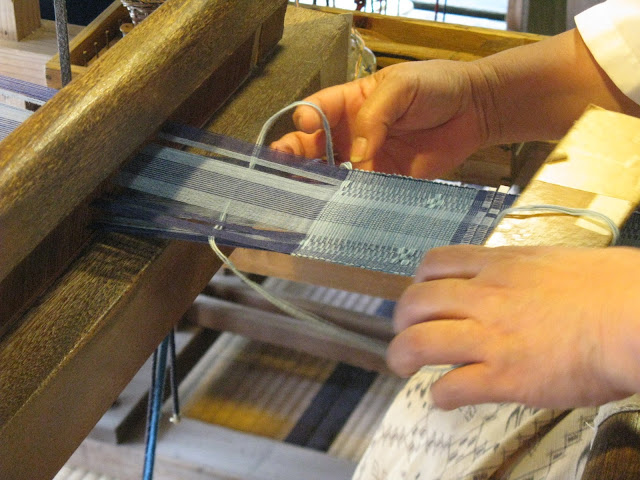We visited a specialist bingata establishment yesterday. Bingata is a traditional stencilling method used in Okinawa. This studio, Ryusen, uses the original method (described below) but has also introduced stencilling with blocks of coral. They cut a block of coral in half and some blocks are shown on the left. Smallest one is about three inches across. One or two are 18 inches across.
Here you can see how they use the coral. A piece of fabric, in this case, silk, is stretched tightly over the coral block and fixed using an elastic band. The dye stuff (natural) is dabbed on to the top of the coral. You can see a large piece of fabric in blue below. The crucial thing about bingata is the use of shading across a stencil. I had not realised this before. If you look at the section she is doing, there is a lot of yellow in it as well as red.
Jars of natural dye material. This studio was set up in the early 1950s by someone who wanted to revive bingata. The Okinawans had a bad time during the World War II. The Japanese and Americans had a last stand here and more than 1 in 8 of the population died. Everything was bombed to bits. The culture is not really Japanese, more Chinese with a strong mix of Indonesian. A man who speaks Okinawan told me that he was very surprised when he went to Indonesian and could understand a lot of what was said.
These are kimono lengths on rollers for stencilling.
And a piece of a kimono length of true bingata. These colours are tradiitonal bingata colours. A kimono length (13 metres) cost a great deal of money - several thousand pounds but they were selling small pieces and I settled for a guard lion-dog on hemp. As usual they wrapped it up so well that I am not undoing it to take a photo!
This is a stencil. It is used by stencilling onto the fabric a resist, traditionally this would be a rice resist. You then paint as you wish . Dry the whole thing, heat set it and then wash out the resist. The studios` stencils were of mulberry paper mounted on fine silk net.
So this is a negative. Now I have to admit that I found the studio was selling stencils and I couldn't walk away from them, could I? I have also to admit that it cost £120.00. However I reckon I know how to use it (see below). Again it is so beautifully wrapped up that no photo is possible. We were given Japanese tea and Okinawan cookies while the wrapping was being done. Okinawan cookies are like a high class Scottish shortbread. Very nice and very un-Japanese.
We went on to visit Shuri castle which was flattened in 1945 and has been totally rebuilt. In the courtyard there was a demonstration of Okinawan dancing going on. You can see that the clothes are different from mainland clothes. They wear something like a long gilet over a kimono.
Main door of the castle - all much more Chinese than Japanese. After that. it was pouring with rain. We made it to tehferry port and Ruth worked out how we could get to the islands which we will do on Wednesday. Today (Tuesday) we are going a bit North to hunt down weaving. Hana-ori and Hanakura-ori.
Yesterday afternoon we went to a different studio and did several hours on bingata!! This is a sample, wrapped in plastic) which I tried to copy. Ruth did fishes. In this case, the fabric had already been stencilled with resist and our job was paint it. Okinawans use set colours, red, yellow, green, blue, purple for the base. Everything has to be painted in one of these colours, then everything is painted over a second time, dried and then 'shadow' colours are used on top. These are darker and are scrubbed in with a circular motion rather than being painted on.
And here I am, concentrating hard on the shadow colours. We hope to finish it later this week and will photograph it then. Ruth took this and I did not even notice.
I managed to buy some brushes from the lady running the class. So I am all set up for using my own stencil at home!!

















































